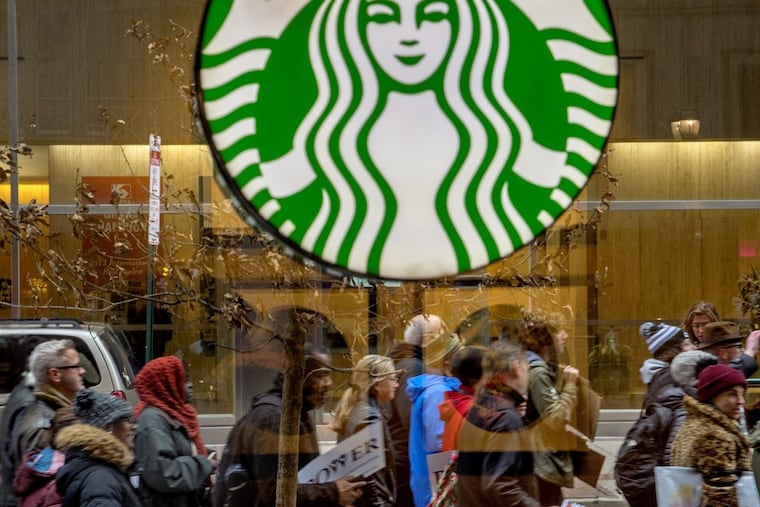Elijah Anderson: Starbucks arrests a rip in the 'cosmopolitan canopy' | Opinion
When black people patronize the local downtown businesses, including coffee shops, jewelry stores, and taxi cabs, they risk being lumped together with the lowly, "the homeless," or people "from the ghetto" - people seen as not deserving of respect that white people can take for granted.

Black people now inhabit all levels of the Philadelphia class and occupational structure. They attend the best schools, pursue the professions of their choosing, and occupy various positions of power, privilege, and prestige. But for the ascendant black upper middle class, in the shadows lurks the specter of the urban ghetto. The iconic ghetto is always in the background, shaping Philadelphians' conception of the anonymous black person as well as the circumstances of blacks in all walks of life.
That's even when they're in Center City's "cosmopolitan canopy," an island of interracial civility located in a sea of segregated living. Here is where there is a bustling exchange of residents, who travel back and forth between the suburbs and the downtown, at all times of the day, but especially during midday and the rush hour. Within Center City, smaller "canopies," include the Reading Terminal Market and Rittenhouse Square, as well as still smaller ones, such as local hospital waiting rooms and food courts, and of course the local Starbucks. These canopies work in tandem to create a synergistic effect, and thus help to make Center City a "cosmopolitan zone." On good days, the Center City area is a civil space, where of all kinds of people appear to get along, enjoying easy interracial and inter-ethnic conversation, and at times, they express a degree of comity.
Anonymous black people, especially young males, based on their strong association with the urban ghetto, are often suspect, and prejudged as dangerous and crime-prone. Unless they display emblems — a suit, a tie — that attest otherwise, they are easily viewed as iconic negroes from the ghetto, places that are stereotyped by many outsiders as drug-infested, persistently poor, and full of "no count," uneducated people.
>> READ MORE: Kudos to Starbucks, but it's going to take more than a workshop to end racial bias | Jenice Armstrong
Thus, when black people patronize the local downtown businesses, including coffee shops, jewelry stores, and taxicabs, they risk being lumped together with the lowly, "the homeless," or people "from the ghetto" — people seen as not deserving of respect that white people can take for granted. Here, the onus is on the black person to disprove this presumption; when this status is not disavowed quickly enough, trouble may erupt.
Thus, as black people move about anonymously through the canopy that is Center City, especially when they are young and male, they do so with a deficit of credibility. They are burdened by their fellow citizens with this distrust until they can prove their credibility as law-abiding citizens. Most of the others making up the canopy display "social gloss," or are polite enough to black people to their face, but any black person knows that he or she is essentially on "thin ice" and generally understands not to "push his luck" by getting "out of place." Doing so will likely provoke the dreaded "N-word moment," that moment of acute disrespect, most typically delivered at the hands of some ethnocentric white person, who is then quick to draw the color line in an effort to "put the black person in his place."
This is roughly what happened in the April Starbucks incident, when two young African American men who grew up in an impoverished black community, but who are now upwardly mobile businessmen, were waiting at the 18th Street Starbucks for the arrival of a colleague.
As they sat quietly, one of the baristas began to scrutinize them. When one of the young men asked for the code to use the restroom, maybe this was too much. Within minutes, the barista summoned the Philadelphia police, who arrived moments later to arrest the young men for what was essentially "sitting in Starbucks while black."
The other Starbucks customers, many of whom were likely to be "cosmos," rose to defend the young black men, complaining about the actions being taken and taking cellphone videos — at least one of which was posted online and made the news.
>> READ MORE: Did Starbucks racial bias training work? Join me to find out | Ronnie Polaneczky
In these circumstances, the black men felt humiliated, deflated, and acutely disrespected. This situation is all too common for black people operating in what they know as "white space," though black people don't expect this sort of thing to happen in spaces that are perceived to be cosmopolitan canopies. In fact, after this "N-word moment" the young men found out that the Starbucks was a white space. They know, as many black people do, that the way you tell a white space is by the frequency and the quality of the "N-word moments" experienced there.
I've argued elsewhere that the "N-word moment," the moment of acute disrespect based on blackness, is the new American color line, which can be drawn out of the blue, but especially when the black person is navigating the white space. When such moments happen under the canopy, the canopy reacts almost immediately. It often does this with a gush of gloss, intended to cover up or repair what just happened. The gloss deflects scrutiny of such incidents for the time being, allowing the canopy a chance to recover. As it does so, things return to normal, awaiting the next such moment.
Elijah Anderson holds the William K. Lanman Jr. Professorship in Sociology at Yale University, where he teaches and directs the Urban Ethnography Project. Among his many publications are "The Cosmopolitan Canopy: Race and Civility in Everyday Life" (2011, W. W. Norton).